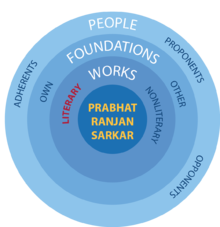User:Sharala/sandbox: Difference between revisions
No edit summary |
No edit summary |
||
| Line 16: | Line 16: | ||
== Synopsis == | == Synopsis == | ||
{{Quote box|width=360px|bgcolor=|align=left|quoted=1|salign=right|quote= | {{Quote box|width=360px|bgcolor=|align=left|quoted=1|salign=right|quote=Sometimes it so happened in the past, and may happen in the future, that if a spiritual aspirant, without the guidance of a strong guru, tried or tries to practise pratyáhára only from reading books, there would be some danger. So whenever you are withdrawing your mental propensities from different objects, you are to guide those collected propensities into some moving object, moving within the realm of your mind.|source=Shrii Shrii Anandamurti}} | ||
Anandamurti starts the discourse by | Anandamurti starts the discourse by explaining the concept of dharana (a dynamic force of concentration within the mind) and its importance to the practice of mind withdrawal. He then explains that the mind's propensities have to be goaded towards the "citta" (objectivated i feeling), otherwise the misguided propensities will create an adverse effect on the mind. next, the citta will be guided towards the ahaḿtattva (the doer I) and the ahaḿtattva towards the mahattattva (pure i feeling). Anandamurti goes on explaining that to achieve a complete freedom from bondage, one has to withdraw all the mental propensities together with the citta, ahaḿtattva and mahattattva and merge them in the Supreme cognition. That last stage is the ultimate goal of human longing.<ref name="AV2"/> | ||
== References == | == References == | ||
| Line 28: | Line 28: | ||
| title = ''[[Ananda Vacanamrtam Part 2]]'' | | title = ''[[Ananda Vacanamrtam Part 2]]'' | ||
| years = 1978 | | years = 1978 | ||
| with = | | with = Pratyáhára Yoga and Paramágati | ||
| before = ''[[ | | before = ''[[Mind and Cognitive Faculty]]'' | ||
| after = ''[[ | | after = ''[[Interpretation of “Ráma” and “Náráyańa”]]'' | ||
}} | }} | ||
{{S-end}} | {{S-end}} | ||
Revision as of 10:17, 8 March 2016
| Pratyáhára Yoga and Paramágati | |
|---|---|
| Speaker | Shrii Shrii Anandamurti |
| Date | 1978 September 24 |
| Place | Patna, India |
| Topic | The process of mind withdrawal |
| Included in | Ananda Vacanamrtam Part 2 |
| Location in Sarkarverse | |
Pratyáhára Yoga and Paramágati is a discourse given by Shrii Shrii Anandamurti on 1978 September 24 in Patna, India. This discourse is the sixteenth chapter of Ananda Vacanamrtam Part 2.[1]
Synopsis
Sometimes it so happened in the past, and may happen in the future, that if a spiritual aspirant, without the guidance of a strong guru, tried or tries to practise pratyáhára only from reading books, there would be some danger. So whenever you are withdrawing your mental propensities from different objects, you are to guide those collected propensities into some moving object, moving within the realm of your mind.
Anandamurti starts the discourse by explaining the concept of dharana (a dynamic force of concentration within the mind) and its importance to the practice of mind withdrawal. He then explains that the mind's propensities have to be goaded towards the "citta" (objectivated i feeling), otherwise the misguided propensities will create an adverse effect on the mind. next, the citta will be guided towards the ahaḿtattva (the doer I) and the ahaḿtattva towards the mahattattva (pure i feeling). Anandamurti goes on explaining that to achieve a complete freedom from bondage, one has to withdraw all the mental propensities together with the citta, ahaḿtattva and mahattattva and merge them in the Supreme cognition. That last stage is the ultimate goal of human longing.[1]
References
| Preceded by Mind and Cognitive Faculty |
Ananda Vacanamrtam Part 2 1978 With: Pratyáhára Yoga and Paramágati |
Succeeded by Interpretation of “Ráma” and “Náráyańa” |
